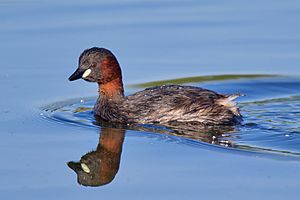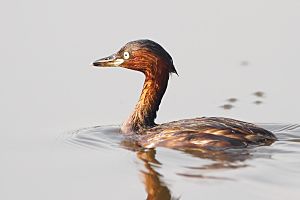Little grebe facts for kids
Quick facts for kids Little grebe |
|
|---|---|
 |
|
 |
|
| Two adults in breeding plumage, below with feathers pressed against the body, for low buoyancy | |
| Conservation status | |
| Scientific classification | |
| Genus: |
Tachybaptus
|
| Species: |
ruficollis
|
 |
|
| Synonyms | |
|
Podiceps ruficollis |
|
The little grebe (Tachybaptus ruficollis), also called the dabchick, is a small water bird. It belongs to the grebe family. Grebes are known for their amazing diving skills. The name Tachybaptus comes from old Greek words meaning "fast" and "to sink under." The name ruficollis means "red-necked" in Latin. This bird is the smallest grebe found in Europe. It is usually about 23 to 29 centimeters (9 to 11.5 inches) long. You can often spot it in open water areas.
Contents
Understanding Little Grebe Classification
Scientists group living things into categories. This helps us understand how different species are related. The little grebe was first described by a German naturalist named Peter Simon Pallas in 1764. He gave it the scientific name Colymbus ruficollis.
Different Types of Little Grebes
There are six types, or subspecies, of the little grebe. They mostly differ in their size and colors. Here are the main ones:
- T. r. ruficollis: This is the original type. It lives in Europe and western Russia, stretching south to North Africa.
- T. r. iraquensis: You can find this type in southeastern Iraq and southwestern Iran.
- T. r. capensis: This subspecies lives in Africa (south of the Sahara Desert), Madagascar, Sri Lanka, and India, going east to Burma.
- T. r. poggei: This type is found from southeastern to northeastern Asia, including Hainan, Taiwan, and Japan.
- T. r. philippensis: This subspecies lives in the northern Philippines.
- T. r. cotabato: This type is found on Mindanao, an island in the Philippines.
What Does a Little Grebe Look Like?
The little grebe is a small water bird with a pointy beak. It looks different depending on the season.
Summer Appearance
In summer, adult little grebes are easy to spot. Their upper bodies are dark. Their neck, cheeks, and sides are a rich, reddish-brown color. They also have a bright yellow area around their beak.
Winter and Young Birds
In winter, the reddish-brown color changes to a dull brownish-gray. Young little grebes also have this brownish-gray color. Young birds have a yellow beak with a small black tip. They also have black and white stripes on their cheeks and neck. As they get older, their yellow beak turns black.
Identifying Features and Calls
In winter, you can recognize the little grebe by its small size and light brown feathers. It also has a darker back and a fluffy rear end. The little grebe's breeding call sounds like a repeated weet-weet-weet or wee-wee-wee. It can sound a bit like a horse whinnying.
Where Do Little Grebes Live?
Little grebes build their nests in small groups. They like freshwater lakes with lots of plants. You can find them across Europe, much of Asia (down to New Guinea), and most of Africa.
Migration Patterns
Most little grebes move to more open water or coastal areas in winter. However, they only migrate if the water in their usual homes freezes over. When it's not breeding season, they might even appear in small bays along the coast.
Little Grebe Behaviour and Life Cycle
The little grebe is an excellent swimmer and diver. It hunts for fish and small water insects underwater. It is very good at using plants in the water to hide from danger.
Nesting and Raising Young
Like all grebes, the little grebe builds its nest right at the edge of the water. This is because their legs are set very far back on their bodies, making it hard for them to walk on land. They usually lay four to seven eggs. When an adult bird leaves the nest, it often covers the eggs with weeds. This helps hide them from animals that might try to eat them. The young birds can swim very soon after they hatch. You can often see the chicks riding on the backs of the swimming adult grebes. In India, these birds usually lay their eggs during the rainy season.
Gallery
See also
 In Spanish: Zampullín común para niños
In Spanish: Zampullín común para niños












